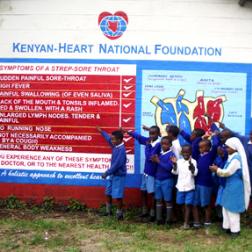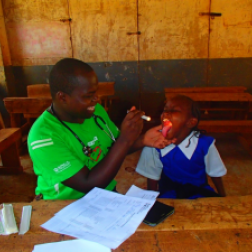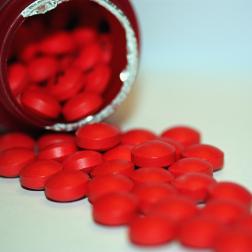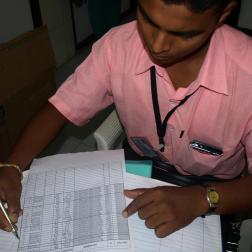Secondary prevention overview
Secondary prophylaxis is the administration of antibiotics to people with a history of RF to prevent GAS infection, subsequent RF recurrence and to minimize progression to RHD. Secondary prophylaxis against RF was first recommended by the American Heart Association in the 1950s and remains the mainstay of disease altering therapy for RHD. Administration of the right antibiotics, at appropriate intervals, consistently over a number of years appears to prevent development of new GAS infections, and subsequent recurrences of RF. Preventing recurrences of RF slows, or perhaps even stops, the development of severe RHD.
A number of guidelines have been developed to guide secondary prophylaxis regimes, providing advice about antibiotic choice, dose, frequency and duration of secondary prophylaxis. Some of these issues are reviewed below.
Antibiotic choice
Benzathine penicillin G
Benzathine penicillin G (BPG) is a penicillin salt administered as a deep intramuscular injection. Low solubility produces prolonged serum penicillin concentrations, detectable in blood for weeks after administration. This low level of penicillin is thought to provide sufficient protection from GAS infection and RF recurrence. All major global guidelines for RHD recommend BPG as the first line choice for secondary prophylaxis. These recommendations are supported by historic trials demonstrating superior protection from regular BPG injections in comparison to oral penicillin therapy.
Evidence for the optimal dose interval suggests that 2 weekly BPG injections are marginally more effective that 3 weekly injections which are more effectively than 4 weekly injections. However, most guidelines recommend a 3 or 4 weekly dose schedule as a pragmatic compromise. The usual adult dose of BPG for secondary prophylaxis is 900mg (1.2 IU). Smaller doses for children are recommended in most guidelines based on weight.
Many countries have experienced stockouts and shortages of BPG in recent years. Background information for governments and pharmacists purchasing BPG can be found in the control section of this site.
Anaphylaxis
Patients and health care providers are understandably concerned about the risk of anaphylaxis from BPG injections.
The best information about adverse reaction and allergy to BPG comes from a paper by the International Rheumatic Fever Study Group in 1991. Between 1988 and 1990 they considered 1790 people from 11 countries having 32,340 injections of BPG.
In this study:
- 57/1790 people (3.2%) had an allergic reaction
- 4/1790 people (0.22%) had anaphylaxis (= 1.2/10,000 injections)
- 1/1790 people (0.05%) died (= 0.31/10,000 injections). This single death occurred in a 15 year old patient with severe mitral valve disease, and congestive heart failure.
- Overall, the disease altering benefit of BPG injections outweighs the small risk of a fatal allergic reaction.
‘Anaphylaxis is a severe, life-threatening, generalized or systemic hypersensitivity reaction’, diagnostic criteria are further outlined by the World Allergy Association. Although there has been considerable concern about anaphylaxis from BPG it remains unclear whether adverse events have been genuine hypersensitivity reactions. Some reported cases do not have a lot of features of anaphylaxis (e.g. swollen airways, difficulty breathing) and other causes (such as contaminated lots of BPG, inadvertent IV injection, or vasovagal episodes in people with severe pre-existing valvular disease) have not always been ruled out. Therefore, the issue of anaphylaxis should be thoroughly investigated before embarking on interventions such as routine skin testing.
Managing the perception of risk from BPG injections is an important part of education and support for an RHD control program. Deaths thought to be associated with penicillin can dramatically undermine community engagement, and risk more lives if people living with RHD cease prophylaxis.
Strong protocols for administering penicillin and managing adverse drug reaction are needed to deliver the medication safely. Wherever possible, people administering BPG should receive detailed training about the management of anaphylaxis: The World Allergy Organization has developed guidelines and resources in different languages which may be adaptable to your setting. Training and equipment will be needed for effective management of anaphylaxis.
All clinicians share responsibility for monitoring and reporting adverse drug reactions and anaphylaxis. More than 65 countries have some kind of medicines agency or pharmacovigilance program. It may be possible to work with medicines agencies to strengthen capacity for monitoring adverse drug reactions for all drugs at a local or national level. Resources are available from the World Health Organization and partners.
Oral penicillin
Phenoxymethylpenicillin (Pen V) may be used for secondary prophylaxis in patients with a strong contraindication to BPG injections. The usual dose is 250mg orally twice daily.
Alternative antibiotics
A small minority of people RHD will have a history of penicillin allergy and be unable to receive BPG or oral penicillin prophylaxis. In these cases, other oral antibiotics will be needed. A number of different oral antibiotics can be used, although all provide inferior protection from RF recurrence.
Strategies to improve adherence with secondary prophylaxis
Identify regular staff to deliver secondary prophylaxis
Building relationships with trusted health workers appears to be an important determinant of adherence with secondary prophylaxis. A single dedicated health care worker responsible for administering BPG and ensuring adherence seems to improve uptake.
“Due to better access to hospitals and improved transportation infrastructure around the island, it is now considerably easier to get the IM penicillin injections. The key to better compliance was enthusiastic, dedicated staff in the Rheumatic Fever Programme and the reminder phone call to remind the patients of the injections.” - Satu Viali, Samoa, 2011
Decentralized dispensing and administration
Local health staff may be able to source, prescribe, dispense or administer secondary prophylaxis in their communities, rather than rely entirely on central providers in larger centers. In Kiribati, the RHD control program worked with the Ministry of Health to shift delivery of BPG from the central hospital to supported local clinics. Legal and regulatory systems may be needed to make this possible - particularly if injections are to be provided by health workers or other people who do not usually administer injections.
Minimise pain and fear of pain
Although there is conflicting evidence about how much pain from injections impacts on patient adherence it is sensible to minimise pain and discomfort. A number of programs have developed injection protocols or guidelines to reduce pain on administration of BPG – some of these suggestions include:
- Use a 21-gauge needle – smaller needles are much more likely to block and increase pain during administration.
- Allow alcohol from swab to dry before inserting needle
- Give the injection as soon as the solution has been mixed, blockages in the needle are more likely to form if there is a delay
- Apply pressure with thumb for 10 seconds before inserting needle
- Deliver injection very slowly (preferably over at least 2–3 min)
- Distract patient during injection with conversation or games
Produce prophylaxis cards
A card recording BPG administration has been a popular option for documenting administered injections and recording the date of the next appointment. In the early years of the WHO control programme BPG cards were produced and countries were encouraged to adapt their own format. The contemporary Pacific RHD Control Programme also uses personal medication cards, adapted to local language and needs.
Explore mobile injection delivery
Some programs can fund home visits by nurses or care workers to deliver secondary prophylaxis injections. Although potentially expensive, this approach reduces inconvenience for people living with RHD and maximizes the opportunities for adherence.
Memory cues
In 2006, the Central Australia RHD control program launched a novel effort to encourage people with RHD to time BPG injections with the full moon. The ‘full moon strategy’ was developed to reflect traditional approaches of Indigenous people living with RHD. A range of interventions - including personal calendar cards, full moon posters and radio advertisements - were developed. A moderate increase in BPG uptake was demonstrated with more consistent uptake during the full moon. Other opportunities may include provision of calendars or development of a smartphone app.
Text messaging and phone calls
Text messages (SMS or texts) can be used to remind people that injections are due. There is some evidence that text messages as health reminders can improve appointment attendance.





